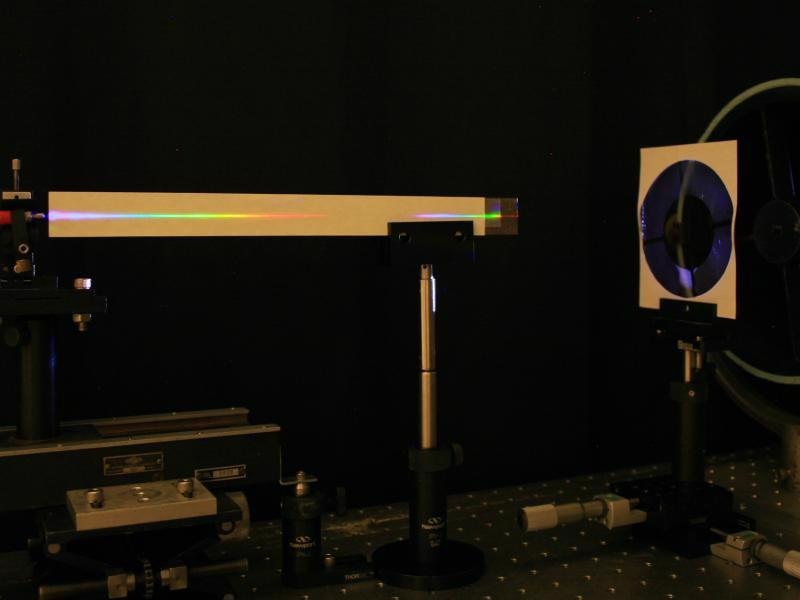A group of scientists has set out to develop holographic lenses that provide visible and infrared starlight into either a focused image or a spectrum. The researchers took their inspiration from an idea for finding exoplanets with a huge space telescope.

Image Credit: Rensselaer Polytechnic University.
The experimental technique, described elaborately in an article, could be utilized to make a lightweight flexible lens, measuring several meters in diameter, that could be rolled for launch and unfolded in space.
The study was recently reported in the Nature Scientific Reports journal.
We use two spherical waves of light to produce the hologram, which gives us fine control over the diffractive grating recorded on the film, and the effect it has on light—either separating light with super sensitivity, or focusing light with high resolution. We believe this model could be useful in applications that require extremely high spectral resolution spectroscopy, such as analysis of exoplanets.
Mei-Li Hsieh, Visiting Researcher, Rensselaer Polytechnic Institute
Hsieh is an expert in optics and photonics and came up with a mathematical solution to control the hologram’s output.
Also, Hsieh holds a faculty position at National Yang Ming Chiao Tung University in Taiwan, together with Rensselaer physicists Shawn-Yu Lin and Heidi Jo Newberg, and collaborated with Thomas D. Ditto, an artist and inventor who conceived the concept of an optical space telescope free of traditional, and heavy, glass mirrors and lenses. Initially, Ditto worked at Rensselaer in the 1970s and is now a visiting researcher in astrophysics.
Telescopes that can be launched into space (to profit from a view unhindered by Earth’s atmosphere) are restricted by the weight and bulk of glass mirrors utilized to focus light, which could realistically extend only a few meters in diameter.
On the other hand, the lightweight flexible holographic lens, which is more precisely known as a “holographic optical element,” utilized to focus light can have a diameter of dozens of meters. Such an instrument could help directly view an exoplanet, a leap over present techniques that detect exoplanets depending on their effect on light coming from the star they orbit. This was stated by Newberg, a Rensselaer professor of physics, applied physics and astronomy.
To find Earth 2.0, we really want to see exoplanets by direct imaging—we need to be able to look at the star and see the planet separate from the star. And for that, we need high resolution and a really big telescope.
Heidi Jo Newberg, Astrophysicist and Expert in Galactic Structure, Rensselaer Polytechnic Institute
The holographic optical element is known to be an improved version of a Fresnel lens, a kind of lens that makes use of concentric rings of prisms arranged in a flat plane to mimic the focusing potential of a curved lens free of bulk.
The idea of the Fresnel lens, developed for use in lighthouses — dates to the 19th century, with modern-day Fresnel lenses of plastic or glass used in camera screens, micro-optics and automobile lamps.
However, while Fresnel holographic optical elements, made by exposing a light-sensitive plastic film to two sources of light at various distances from the film, are more common, current methods were restricted to lenses that could be capable of only focusing light, instead of isolating it into its constituent colors.
The latest technique enables the designers to either focus the light onto a single point or to scatter it into its constituent colors. This helps produce a spectrum of pure colors, stated Lin, corresponding author and a Rensselaer professor of physics, applied physics and astronomy.
The technique makes use of two sources of light, placed very close to one another, which make concentric waves of light that — as they travel toward the film — either build or cancel each other out.
The tuning of this pattern of convergence or interference can be done depending on the formulas developed by Hsieh. It is printed, or “recorded,” onto the film as a holographic image and, based on how the image is structured; light passing via the holographic optical element is either focused or expanded.
We wanted to stretch the light, so that we could separate it into different wavelengths. Any Fresnel lens will stretch the light a little, but not enough. With our method, we can have super resolution on one end, or super sensitive — with each color separated. When the light is stretched like that, the color is very good, as pure and as vivid as you can get.
Shiuan-Huei Lin, Expert in Photonic Crystals and Nano-Photonics, Department of Electrophysics, National Yang Ming Chiao Tung University
Journal Reference:
Hsieh, M.-L., et al. (2021) Experimental realization of a Fresnel hologram as a super spectral resolution optical element. Scientific Reports. doi.org/10.1038/s41598-021-99955-w.